Indigenous clients
On this page
Key findings: Indigenous SHS clients, 2021–22
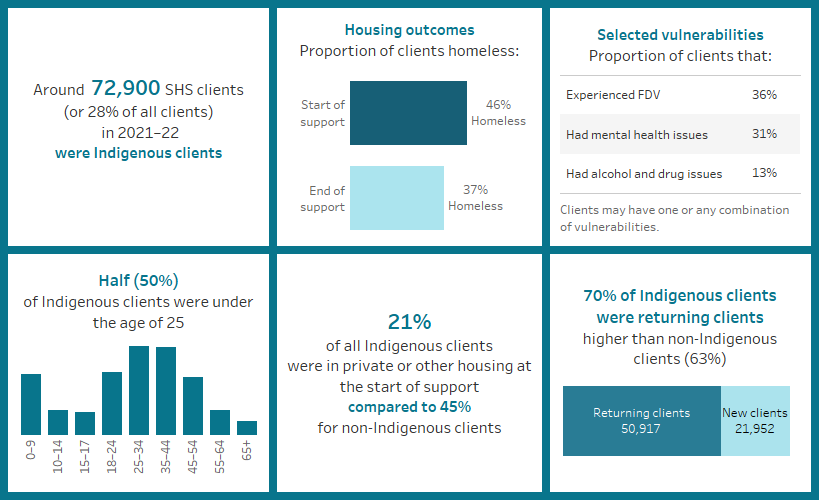
A safe, secure home with working facilities is a key support for the good health and wellbeing of Aboriginal and Torres Strait Islander people. Historically, Indigenous Australians have been over-represented among people experiencing homelessness and among those seeking assistance with housing.
Aboriginal and Torres Strait Islander people make up around 3.2% of the Australian population (ABS 2022a) yet they made up around 20% (23,437 persons) of the estimated number of people experiencing homelessness on Census night in 2016 (ABS 2018) and over one-quarter or 28% of the clients (an estimated 72,900 clients) assisted by specialist homelessness services (SHS) in 2021–22. Not having affordable, secure and appropriate housing can further compound the social exclusion and disadvantage experienced by some Indigenous people (AIHW 2021).
Severe overcrowding as a form of homelessness is particularly prevalent in Indigenous families and communities. Indigenous Australians are more than 3 times as likely to live in overcrowded conditions than non-Indigenous Australians (AIHW 2021) and almost 3 times as likely to need one or more extra bedrooms compared with other households (ABS 2022b), even though the Census estimates may under-represent the extent of homelessness among Indigenous people.
Findings from the House of Representatives Standing Committee Inquiry into Homelessness (HRSC 2021) recommended a review of the data collection and estimation methods. The inquiry recommended greater inclusion of Indigenous Australian cultural practices and perspectives, particularly regarding the circumstances in which persons living in severely crowded dwellings and boarding houses should be categorised as homeless. The findings also highlight the effectiveness and appropriateness of Aboriginal community-controlled housing services, and recommended the development of a national integrated approach to housing and homelessness services for Indigenous Australians, co-designed with Indigenous community-controlled organisations and grounded in the principle of self-determination.
The 2020 National Agreement on Closing the Gap includes the socio-economic outcome that Aboriginal and Torres Strait Islander people can secure appropriate, affordable housing that is aligned with their priorities and need (COAG 2022). Under this outcome, by 2031, the proportion of Aboriginal and Torres Strait Islander people living in appropriately sized (not overcrowded) housing will increase to 88%. Key indicators to measure the progress made against the target include the homelessness rate, including by type (e.g. transitional housing/sleeping rough) and age group.
Under Closing the Gap, housing is one of five policy priority areas identified as requiring a joined up approached between the Commonwealth, states and territories and Aboriginal representatives, to identify opportunities to work more effectively across governments, reduce gaps and duplication, and improve outcomes. Housing is also one of four sectors that have been identified for joint national sector strengthening plans. The Housing Sector Strengthening Plan was approved by the Joint Council on Closing the Gap on 26 August 2022 and is in the initial phases of implementation.
Aboriginal and Torres Strait Islander people are a national priority cohort in the National Housing and Homelessness Agreement, which came into effect 1 July 2018 (CFFR 2018) (see Policy section for more information). This agreement provides a framework for all levels of government to work together to improve housing and homelessness outcomes for Indigenous Australians (AIHW 2019).
Over 314,100 Indigenous clients have been supported by homelessness agencies since the Specialist Homelessness Services Collection (SHSC) began in July 2011. The number of Indigenous clients has been steadily increasing over this time, most notably (Historical data table HIST.INDIGENOUS):
- Changes in the number of Indigenous clients over time may reflect improved Indigenous status data among people receiving SHS support. That is, there has been a substantial decrease in the proportion of SHS clients with ‘not stated’ Indigenous status over time, from 8.3% (35,600 clients) in 2011–12 to 3.4% (16,200 clients) in 2021–22.
- The rate of service use by Indigenous clients increased from 753.8 clients per 10,000 Indigenous people in 2017–18 to 798.7 in 2021–22.
- The ratio between the rate of Indigenous SHS clients compared with non-Indigenous clients has increased, from 8.8 in 2017–18 to 10.1 in 2021–22.
- The total number of Indigenous clients who received support from SHS agencies increased by an average rate of 5.3% annually over the 11 years to 2021–22, 3 times that of non-Indigenous clients (1.6% over the same period).
Client characteristics
Figure INDIGENOUS.1: Key demographics, Indigenous SHS clients, 2021–22
This interactive image describes the characteristics of around 72,900 Indigenous clients who received SHS support in 2021–22. Most clients were female, aged 18–34. The number of Indigenous clients has been increasing, while ‘not stated’ has decreased. New South Wales had the greatest number of Indigenous clients and Victoria had the highest rate of Indigenous clients per 10,000 population. The majority of clients had previously been assisted by a SHS agency since July 2011. More than half were at risk of homelessness at the start of support. Around a third of Indigenous clients received SHS support in major cities, while most non-Indigenous clients received support in major cities.
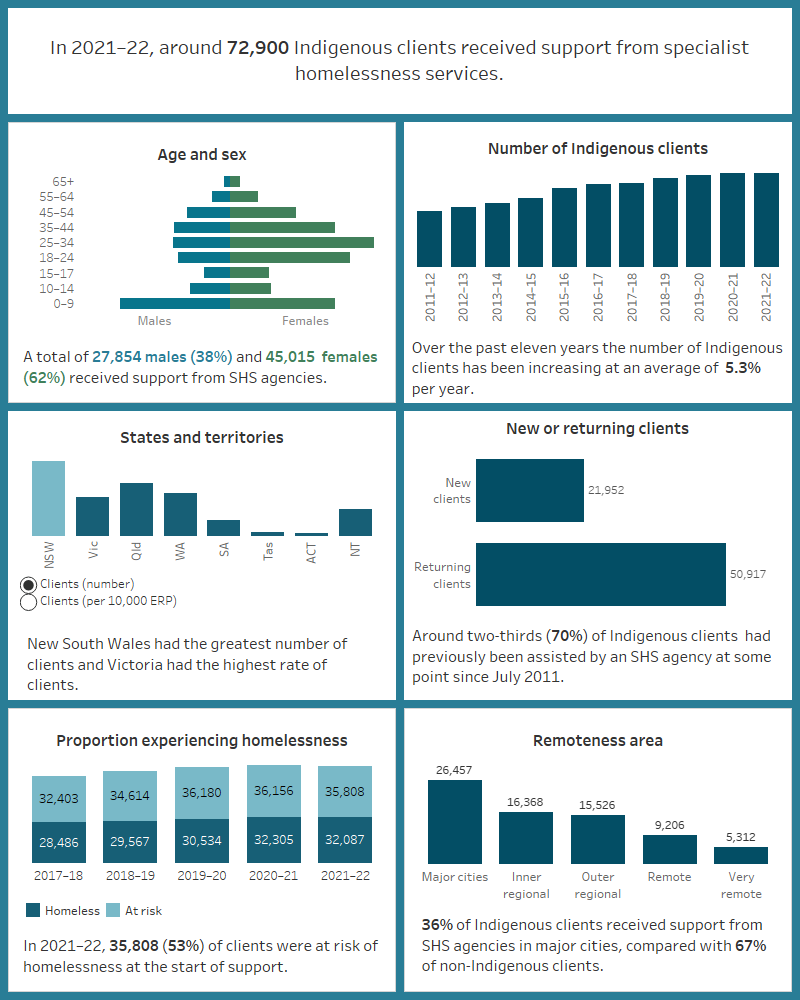
Presenting unit
In 2021–22, over half of the Indigenous clients presenting to a SHS agency presented alone (58% or almost 42,300 clients) and a further 32% (or almost 23,500 clients) presented as a single parent with child/ren (Supplementary table INDIGENOUS.9).
Living arrangements
In 2021–22, at the beginning of support (Supplementary table INDIGENOUS.10):
- Indigenous clients (34% or about 23,900 clients) were most likely living as a single parent with child(ren).
- One in 4 (around 18,400 or 26%) Indigenous clients were living alone.
- A further 18% (or around 12,200) Indigenous clients were living with other family.
Selected vulnerabilities
SHS clients can face additional vulnerabilities that make them more susceptible to experiencing homelessness, in particular family and domestic violence, a current mental health issue and problematic drug and/or alcohol use (Supplementary table CLIENTS.45).
- Less than half (44% or around 25,600) Indigenous clients did not experience any of the selected vulnerabilities, which was higher than the rate for all SHS clients (39%).
- Indigenous clients had a higher rate of reported problematic drug and alcohol use (13% compared with 10% for all SHS clients), a similar rate of Indigenous clients reported experiencing family and domestic violence (36% compared with 37%), and a lower proportion of Indigenous clients reported experiencing a mental health issue (31% compared with 37%).
Figure INDIGENOUS.2: Indigenous clients, by selected vulnerability characteristics, 2021–22
This interactive bar graph shows the number of Indigenous SHS clients also experiencing additional vulnerabilities, including family and domestic violence, having a current mental health issue and problematic drug and/or alcohol use. The graph shows both the number of clients experiencing a single vulnerability only, as well as combinations of vulnerabilities, and presents data for each state and territory.
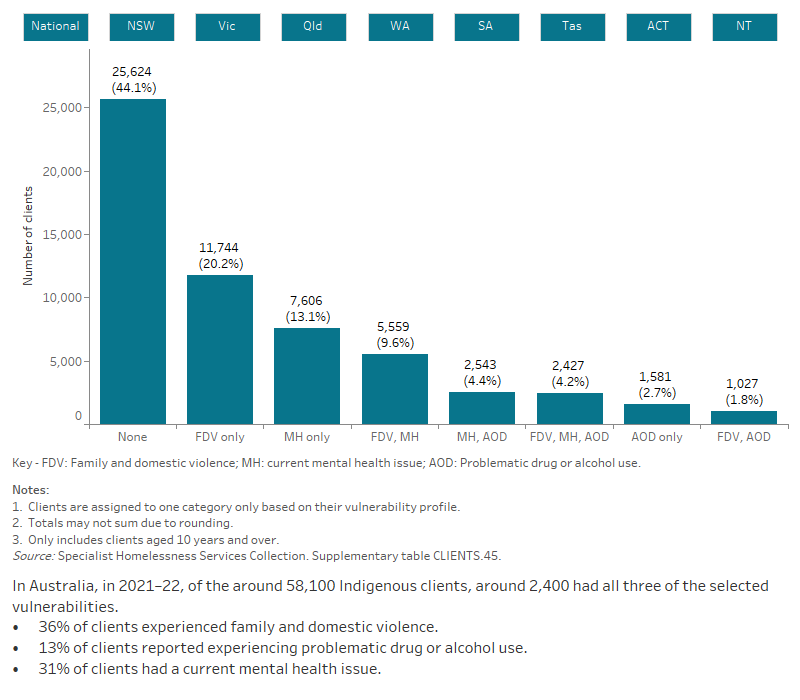
Service use patterns
The median length of support received by Indigenous clients increased to 57 days in 2021–22, up from 48 days in 2017–18. The average number of support periods per client was 1.8 in 2021–22. The proportion of clients receiving accommodation decreased from 41% in 2017–18 to 39% in 2021–22, while the median number of nights accommodated decreased from 20 in 2017–18 to 17 in 2021–22 (Supplementary table CLIENTS.46).
New or returning clients
In 2021–22, around 70% of Indigenous clients were returning clients (that is, those who had received SHS services at some point since the collection began in July 2011), higher than the proportion of returning non-Indigenous clients (61%). Around one-third of Indigenous clients were new clients (30%) (Supplementary table INDIGENOUS.7).
Main reasons for seeking assistance
The 3 most common main reasons why Indigenous clients sought assistance from SHS agencies in 2021–22 were (Supplementary table INDIGENOUS.8):
- family and domestic violence (24% or 17,100 clients)
- housing crisis (19% or 13,700 clients)
- inadequate or inappropriate dwelling conditions (13% or almost 9,300 clients).
Services needed and provided
In 2021–22, the need for accommodation assistance was broadly similar between Indigenous and non-Indigenous clients, with the exception of short-term or emergency accommodation (Supplementary table INDIGENOUS.3).
Half of Indigenous clients (51% or 37,200) needed short-term or emergency accommodation, higher than the proportion of non-Indigenous clients (37% or 68,400). Two-thirds of Indigenous clients who needed short-term or emergency accommodation received this support (63%); a higher proportion than non-Indigenous clients (56%).
For some general services, needs were higher for Indigenous clients when compared with non-Indigenous clients, including meals (28% compared with 11%), laundry/shower facilities (22% compared with 6.6%) and transport (25% compared with 12%).
Figure INDIGENOUS.3: Indigenous clients, by services needed and provided, 2021–22
This interactive stacked horizontal bar graph shows the services needed by Indigenous clients and their provision status. Advice/information was the most needed and most provided service. Long term housing was the least provided service.
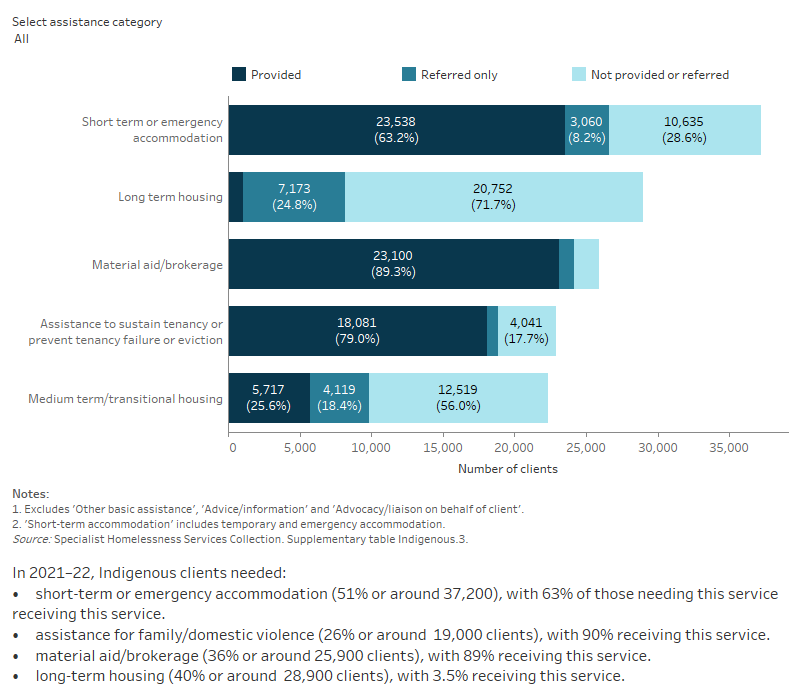
Housing situation and outcomes
In 2021–22, at the beginning of the first support period, more than half (53%) of clients whose Indigenous status was known presented to services at risk of homelessness, while less than half (47%) were experiencing homelessness. These proportions have remained consistent since 2017–18 (Supplementary table CLIENTS.12).
Outcomes presented here highlight the changes in clients’ housing situation at the start and end of support. That is, the place they were residing before and after they were supported by a SHS agency. The information presented is limited only to clients who have stopped receiving support during the financial year, and who were no longer receiving ongoing support from a SHS agency. In particular, information on client housing situations at the start of their first period of support during 2021–22 is compared with the end of their last period of support in 2021–22. As such, this information does not cover any changes to their housing situation during their support period.
By the end of support, many clients have achieved or progressed towards a more positive housing solution. That is, the number and/or proportion of clients ending support in public or community housing (renter or rent-free) or private or other housing (renter or rent-free) had increased compared with the start of support.
For Indigenous clients with closed support (Supplementary table INDIGENOUS.4):
- At the start of support, Indigenous clients were about 3.5 times as likely to be in public or community housing (30%) compared with non-Indigenous clients (8.8%), while non-Indigenous clients were about twice as likely to be in private or other housing (45%) compared with Indigenous clients (21%).
- At the end of support, Indigenous clients were about 2.6 times as likely to be in public or community housing (38%) compared with non-Indigenous clients (15%), while non-Indigenous clients were about twice as likely to be in private or other housing (50%) compared with Indigenous clients (23%).
- At the end of support, fewer Indigenous clients were known to be homeless, decreasing from 46% at the start of support to 37% at the end; more Indigenous clients were living in housing with some form of tenure, mainly an increase in clients living in public or community housing (from 30% to 38%).
Figure INDIGENOUS.4: Housing situation for Indigenous clients with closed support, 2021–22
This interactive Sankey diagram shows the housing situation (including rough sleeping, couch surfing, short-term accommodation, public/community housing, private housing and institutional settings) of Indigenous clients with closed support periods at first presentation and at the end of support. The diagram shows clients’ housing situation journey from start to end of support. Most clients started and ended support in public housing.
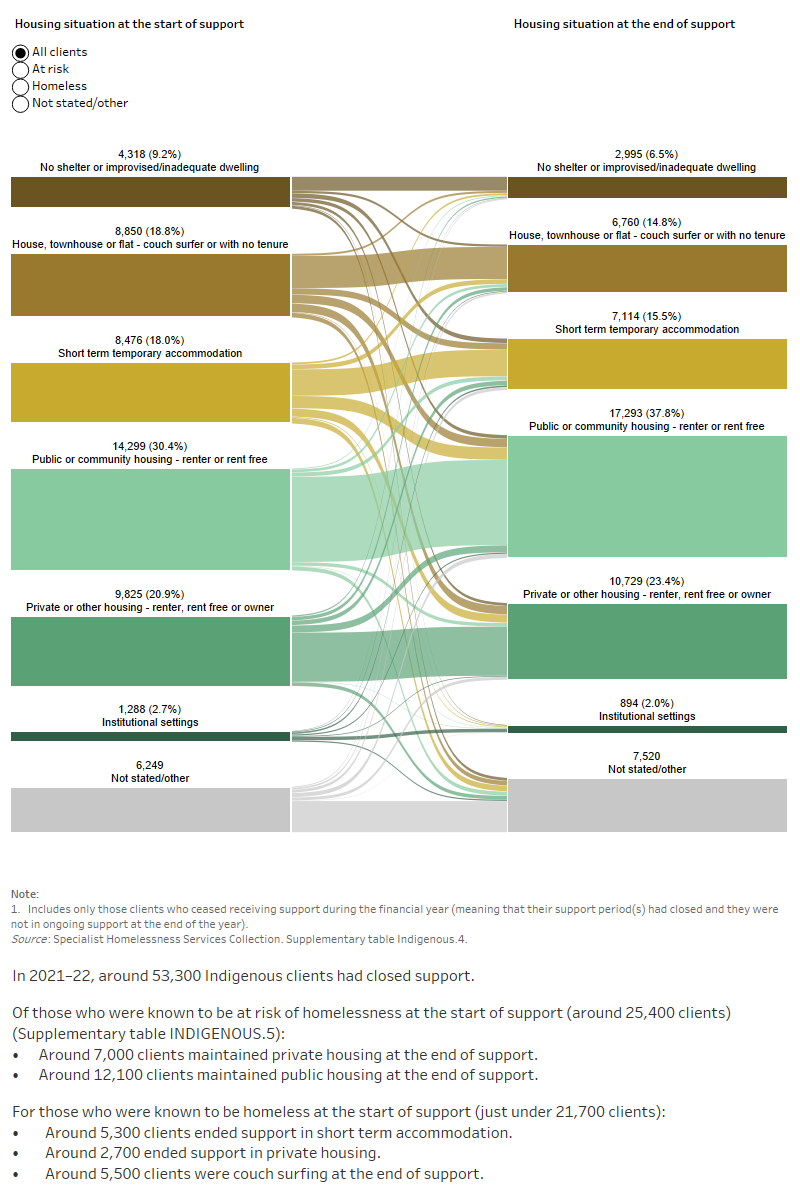
Australian Bureau of Statistics (2022a) Census of Population and Housing - Counts of Aboriginal and Torres Strait Islander Australians, ABS website, accessed 26 September 2022.
Australian Bureau of Statistics (2022b) Housing Suitability (HOSD) by Indigenous Household Indicator (INGDWTD) [Census TableBuilder], ABS website, accessed 27 September 2022.
Australian Bureau of Statistics (2018) Census of Population and Housing: Estimating homelessness, ABS website, accessed 26 September 2022.
Australian Institute of Health and Welfare (2021) Indigenous housing, AIHW website.
Australian Institute of Health and Welfare (2019) Aboriginal and Torres Strait Islander people: a focus report on housing and homelessness, AIHW website.
Council on Federal Financial Relations (2018) National Housing and Homelessness Agreement, CFFR website, accessed 23 January 2019.
Council of Australian Governments (2022) National Agreement on Closing the Gap, COAG website, accessed 13 October 2022.
House of Representatives Standing Committee (2021) Final report: Inquiry into homelessness in Australia, HRSC website, accessed 24 September 2021.


